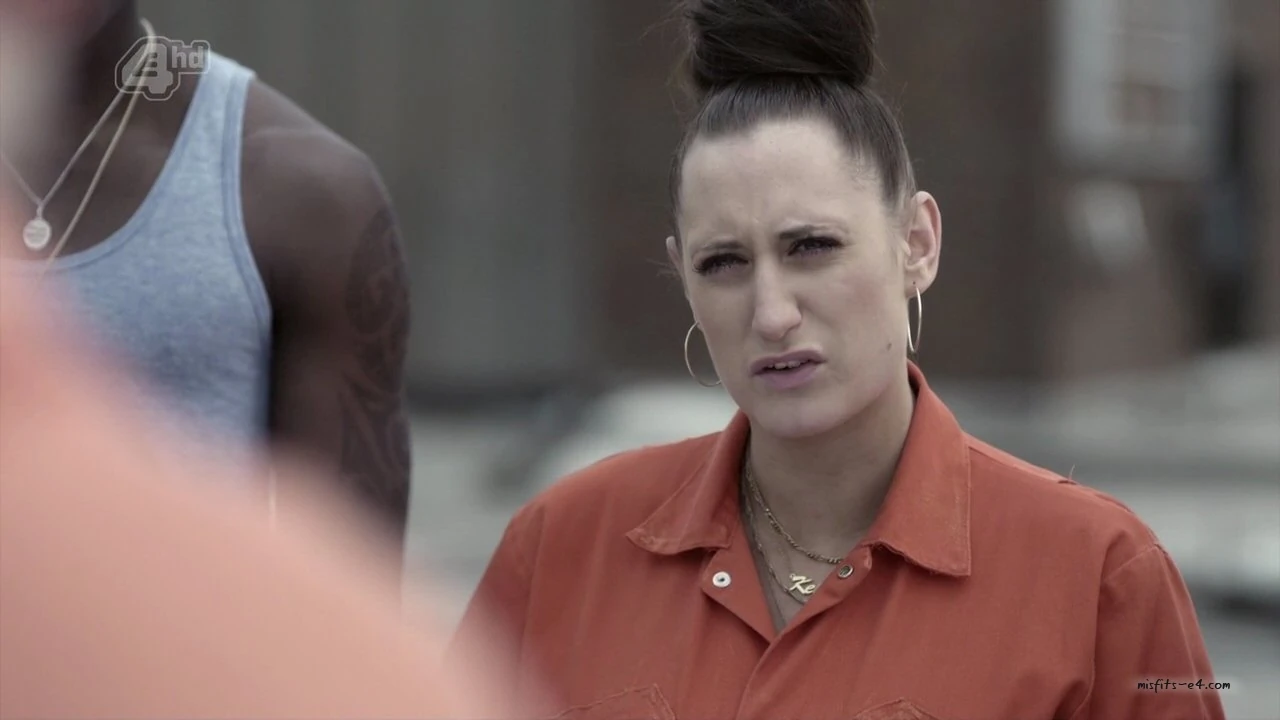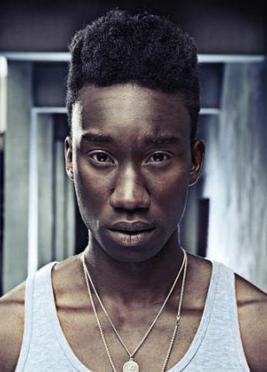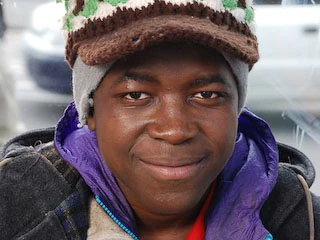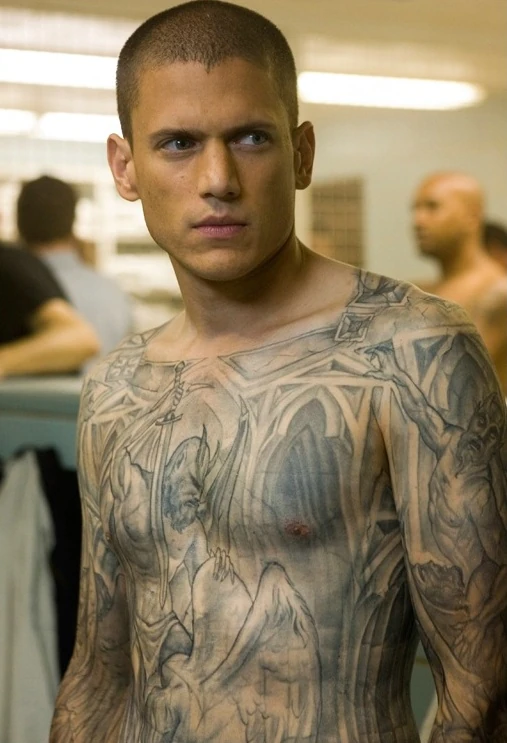Successful media products depend as much upon marketing and distribution to a specific audience as they do upon good production practices.
To what extent would you agree with this statement within the media area you have studied.
I believe that for a film to be successful it needs to be a four-quadrant film that incourparates Mark Kermodes rules of blockbusters. Which includes if you make the movie an event, it will increase publicity, turning into profit. He also talks about you have to have the following things; the film has to be newsworthy, a big budget, a list stars and money on screen not a comedy.
An important aspect of this is the production practices by hiring an A list cast, which would generate press interest. In Mad Max Fury Road the cast were already famous actors such as Tom Hardy (Max), Charlize Theron (Furiosa) and Nicholas Hoult (Nux.) This would help with the marketing later on as they are already well known so people who like the certain actors will go to see it. Using these very critically acclaimed actors such as Tom Hardy who bring animal charisma this allows him to play the part of Mad Max as although he does little talking his body language does the acting for him. The risk of hiring actors like this would be that they annoy other actors by their methodical ways. This could affect the film in many ways as as the actors around him may refuse to work with them, this would in turn make bad press. An example of this is in Mad Max as whilst filming Charlize Theron did not like Tom Hardy because she thought he was ignorant as he didn't talk to her throughout filming. Whereas in such films as Ex Machina where the actors are not well known yet but will be in an upcoming movie of the same genre (Star Wars) Caleb played by Domhnall Gleeson. It will increase profit later on as the public's love of the actors grows. This is good because it is really free advertising for the film as mainstream viewers who go to see Star Wars will then be encouraged to go see Ex Machina.
The ideas for film also aid the marketing and distribution by aiming at the specific audience who watched the earlier films. Mad Max was the fourth in the sequel so the audience that have watched the other three are more likely to go watch it. This encourages the mainstream audiences to go again as the other Mad Max films were well known for being good they feel that if they don't go to see Fury Road they will be missing out. Ex Machina is extremely like films such as blade runner and 2001. Therefore their specific audience would be those who enjoyed science-fiction films like these. The audience for Mad Max is bigger as it caters for more specific audiences as it is from the action genre, many generations enjoy watching action films so that will increase the audience of Mad Max. Whereas Ex Machina is just aimed at males who enjoy sci-fi which is a smaller amount of the population.
Four quadrant films have more success as they have a wider audience take, this often means that to be successful action and explosions have to be included at some stage. Having a wider audience does not make the film better just more successful because if more people go to see the film it does not mean that the film is better. Mad Max appeals to the males audience as there is constant action and explosions. But it does not put women off because Furiosa (Charlize Theron) is the hero of the film. This is uncommon For blockbusters like this. On the other hand Ex Machina is not a four quadrant film meaning that it was more important to make the marketing and distribution specific for the science-fiction male audience,
The camera effects used within the film will help with marketing and distribution because if the camera can take 300 frames per second like the Phantom camera used in Mad Max. The shots will look cleaner and more detailed increasing the quality. The edge arm that was also used shows synergy whithin the film. If a film is shown in 2D, 3D and IMAX it gives the audience a wider choice to choose where to see it. Mad Max production practices are shown when the war rig is blown up, the explosion actually happened and because it was shot with such a good camera the quality is outstanding. There was an actual stunt driver in the war rig when it took place to ensure that the crash happened like Miller wanted it to. The beginning of the film shows the choice of actor as you can see Max (Tom Hardy) as almost a lone wolf in a desert land fighting for survival. He is unwashed, unshaven and grunts just like an animal would. He makes the scene very believable to the audience as he becomes his character to every last detail. The musical rig which follows the action around shows how well the editing was done and incorporating sound builds the tension for the audience. The wires and sound were edited out afterwards. In Ex Machina one of the first scenes of the films showed the large house and the surroundings. It entices the audience as the set and atmosphere was made interesting. The way they created Ava the robot was taking two shots of every scene then drawing her body over the actors afterwards in editing, at the middle of the film she puts clothes on so the editing stages were quicker. The only part of action that went on in the film was when Ava stabbed her creator to insure that she would be able to escape. This including action will appeal to the wider specific audience of action.
Marketing to specific audiences is important as it builds up interest into your film. The most effective way to do this is through traditional ways such as Tv ads that engage a wider audience. Mad Max spent $7 million on Tv advertisement which very much contributed to the success of the film. This is because more people watch Tv of all ages, aiding the marketing of films. There are also untraditional ways such as making a formula One car look like a war rug this attracts men as they watch this sport more. These ways also cost a lot of money. Another way that Mad Max marketed their film was through billboards and posters on bus stops or cinemas. This is a very common way that films such as this would advertise because it works by attracting a wide range of audience from across the country. Mad Max needed a strong marketing technique because of the delays and problems they had in production. This is why a lot of money was spent on this area. On the other hand smaller films use viral marketing that is free. An example of this would be Ex Machina who did a tinder account to a organise a fake meeting with Ava the robot in the film. This was even as a brilliant way to reach the younger audience. They also released teasers that left the audience on cliffhangers so that they will watch the film to see what happens, they also did this on YouTube so it was free. Another way that they targeted online users was by making the website Avasession.com this is were users can go and meet ava and she will draw a picture of them like in the film. This was particularly popular with teenagers but in all was not very successful as it did not produce much revenue for the film. Audiences challenge the marketing of films by pirating films, this is why action films have been made bigger and better. If the action films are bigger and better it will encourage the audience to go to the cinema to see it to get the full effect, this will also happen when the films are put in 3D as not many of the audience have a 3D TV. You will not get the same effect watching it at home as you would watching it in the cinema with surround sound.
Distribution in films is a massive part of a films success because the more it is distributed the more people go to watch it, increasing the amount of money made at the box office, in turn increasing the profit. The more effective the distribution the more it will encourage the audience to go and see it. as in Ex Machina their distribution was effective. A famous distribution company that is used for distributing films to specific audiences such as Universal Studios (Ex Machina) and Warner Bros Pictures (Mad Max.) The amount of screens that the film is shown on makes a huge difference to the amount of box office profit made. Mad Max played on 12000 whereas Ex Machina was only on 1,225. Although Ex Machina very cleverly piggybacked Avengers as going to the cinema once encourages people to go again soon after. Mad Max was also brought out in the summer, blockbuster season, allowing more people to go and see it because of the holidays across the world.
In conclusion from what I have wrote above, action films are more successful. This is because larger specific audiences enjoy them. I predict that over the next five years the most common film to be made will be action. For example there is 50 upcoming Marvel films.
Friday 27 November 2015
Wednesday 25 November 2015
Class&Status
Class & Status
Find two examples (a mixture of images and clips) from UK and US TV dramas for each of the following:
- Upper Class (rich/posh)
- Middle Class (neither rich nor poor/in the middle)
- Working Class (poor/common)
Add a brief justification for each choice
High Class;
Lady Grantham- She owns Downton Abbey and therefore is very wealthy in her lifestyle, this is shown by her accent, attire and her gestures. She is very posh and looks down on lower class people although she can be friendly to them occasionally. She has a lot of money which is portrayed how they are in the middle of a war and still she has a lot of money, she is not affected by the circumstances. She doesn't work and has never worked before because she has never needed to.
Sherlock- From the programme Sherlock, he is always dressed in a suit or very smartly and in the show you never see him in casual dress. His accent is very posh and he looks down heavily at people who are not in the same class as him. This is shown in the way he treats his 'side-kick'. His job as a detective is very well looked at and he is high up in his work status as he is very good at his job.
Middle Class-
Clara- This character is from Doctor Who, she appears in a couple of the series as the girl who accompanies the doctor on his missions. She is from London and this is portrayed by the use of her language and tone. The doctor often looks upon her as strange in the way she says some words differently to him. She is not poor but she is not rich either, she lives in a semi-detached house and she wears semi-smart clothing.
Brad Bellick- Is a correctional officer in the TV Drama Prison Break. He has an average job and is not high up in his positioning as there are people much higher then him. He always looks smart in his uniform and appears well put together. He lives with his mother in a rural village and he looks quite comfortable, no money problems come across. He could be better off but he is not poor.
Working Class-
Kelly- This character is from Misfits, she is doing community service showing that she does not have good morals, stereotypically associated with lower class. She wears chavy clothing such as low tops, gold jewellery and big hoop earrings. Her accent is very strong and she often cusses and uses slang instead of standard English. In the show it shoes how she lives on benefits in a council estate.
T-Bag- This character from prison break is clearly lower class not only because he says that his dad sexually assaulted his disabled sister but also by the way he asks himself. He is very scruffy and often results to violence when he doesn't get what he wants. He is paedophilic rapist which shows he again has no morals as he was taught them as a child. He does not look after himself or others in anyway, he also has no money which is another factor of why he has resulted to breaking the law.
Friday 20 November 2015
British Film Industry
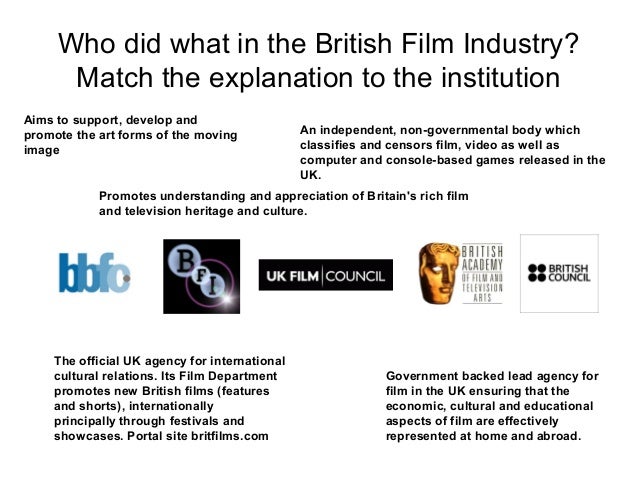
bbfc- An independent, non-govermental body which classifies and censors film, video as well as computer and console-based games released in the UK.
BFI- The official UK agency for international cultural relations. Its Film department promotes new British Films (features and shorts) internationally principally through festivals and showcases. Portal site ritfilms.com.
UK Film Council-Promotes understanding and appreciation of Britain's rich film and television heritage and culture.
British Academy- Aims to support, develop and promote the art forms of the moving image.
British Council- Government backed lead agency for film in the UK ensuring that the economic, cultural and educational aspects of film are effectively represented at home and abroad.
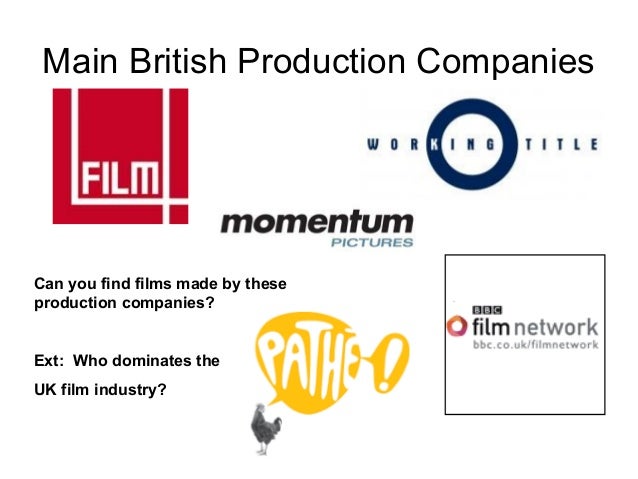
Film 4 Films: Ex Machina
PATHE Films: 127 Hours
Momentum Pictures Films: The woman in Black (sequel)
Working Title Films: Theory of everything
BBC Film Network: The Lady in the Van
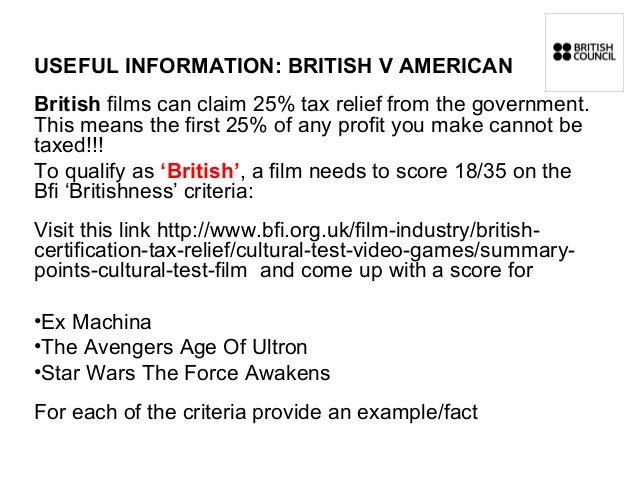
British V American
Ex Machina Score-32
Avengers- 22
Star Wars The Force Awakens-23
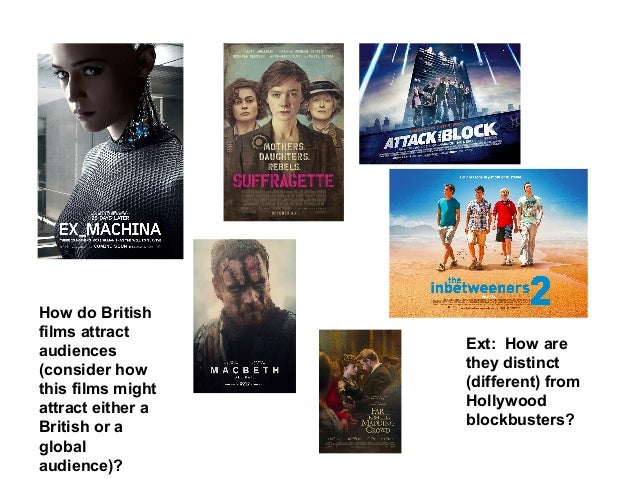
Suffragette- This film will attract British audiences as it a major part of British History, therefore people will want to see it to learn more about it. The female audience will also be attracted as it is about women fight against the rules and laws that are patriarchal.
Ex Machina- The British audience will want to see this as it is different to the average film and it is just generally births.
Attack the Block- It is a British film that appeals to everyone in Britain because of the sense of humour that is based in Britain.
Macbeth- This is also a part of British background as Shakespeare is a famous playwright that is taught in all schools across the British Nation.
Inbetweeners 2- is attracting to British audiences because the first film did really well and is still popular. Also it again applies to the British sense of humour.
Far from the madding crowd- this would appeal because it is just very British everything about it is British.
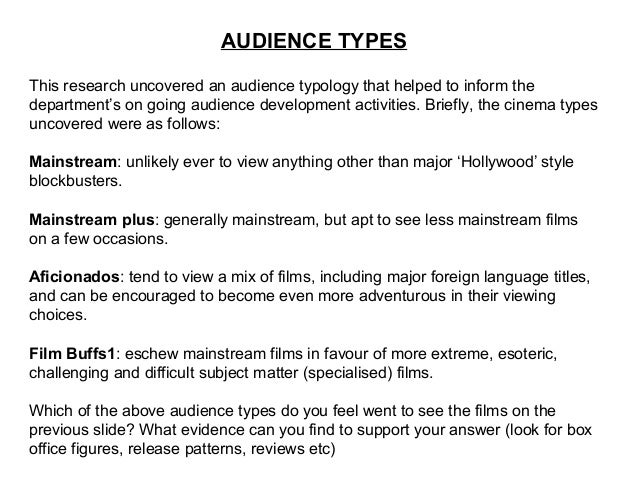
Inbetweeners 2- Mainstream $63.8 million at the box office
Far from the madding crowd- Aficionados $30.2 million at the box office
Macbeth-Aficinados $5.2 million
Attack the Block- Aficionados $5.8 million
Ex Machina- Film Buffs $37 million at box office
Suffragette- Mainstream plus $14.5 million

I think the reasons fro having a British film industry is that they allow a film to get the first 25% of the profit to be tax free. This allows american films to make their film partly British and gain more profit then they would if it was american. The scripts are also all in English which allows most of the world to understand them as most countries have English as a first or second language. It is simply to make money.
Thursday 19 November 2015
Examples of Ethnicity in TV Drama:
Examples of Ethnicity in TV Drama;
Black:
Curtis From Misfits: The representation of Curtis is very stereotypical as he is doing community service meaning that he committed a crime so might be dangerous. Also he listens to hip-hop music, wears baggy trousers and likes girls of the same ethnicity as him.
Thomas From Skins: Thomas is a stereotypical immigrant as in the show he has immigrated to the country with little money and only a place in a council estate. He eats stereotypical things such as curry and hot chillies 'that his mum used to grow on the farm.' He then turns into a drug dealer to gain money.
Crazy Eyes from Orange is the new Black: She is stereotypical in the way that she only talks to people in the prison of her own ethnicity and in her younger life had strict discipline. She is not stereotypical as she has a disability which makes her childlike in her ways.
White:
Michael from Prison Break: He is very stereotypical as he works in an office building and wears a suit. He cares about his brother a lot as he try to get him out of prison. He is also extremely short, calm and could be described as boring in some respects.
Tate from American Horror Story: He is the opposite to every stereotype of a white person in the first series as he is a serial killer with no remorse or sympathy. He always talks about death because he is in fact dead. He falls in love with a girl who is younger them him but their relationship was not normal.
Effy from Skins: She is a stereotypical white teenage girl, she is lazy, rebellious and is in several different relationships with different boys. She still manages to do well at school and in the last seres she has an office job which she does not like.
Chinese:
Agent May from Agents of Shield: a stereotypical view of the asian is that they are really good at martial arts. Agent May is an extremely good fighter and she knows everything to know about martial arts.
Anita from Humans: Anita is very smart as she pretends to be a robot although she can have thoughts and feelings, she knows exactly how to manipulate people. This is stereotypical because the Chinese are thought to be very smart. She is also very calm and collective.
Maski Oka from Heroes: Again he is the smart one of the group and he is great at computer science. Like the stereotypical asian he is the one behind the scenes doing all the brain work rather then doing all the fighting.
Asian:
Anwar from Skins: He is very stereotypical in some of his ways and counteracting in others. H is religious and you often see him at church or praying, his family are very strict and do not let him drink alcohol. Although he does drink alcohol and do drugs he still gets good grades.
Martina from Orange is the New Black: She was stereotypical food and is stereotypical to a teenage rebellious asian. She enjoys doing her makeup and bitching about others in the prison She is obsessed with boys and has a close best friend of the same ethnicity.
Emily from Pretty Little Liars: She very intelligent and does very well with her school work, she follows what her parents say and does not like to break the rules. She is also hardworking in her swimming. She counteracts the stereotype of asian people by being gay as in their community it is not often accepted.
Wednesday 18 November 2015
Ethnic Information from Mr Ford's Blog
Narrative Codes

Narrative Codes
Roland Barthes developed a concept that every narrative is interwoven with five codes that drive one to maintain interest in a story. The first two codes involve ways of creating suspense in narrative, the first by unanswered questions, the second by anticipation of an action's resolution. These two codes are essentially connected to the temporal order of the narrative.
The Hermeneutic Code
The hermeneutic code refers to plot elements of a story that are not explained. They exist as enigmas that the reader wishes to be resolved. A detective story, for example, is a narrative that operates primarily by the hermeneutic code. A crime is exposed or postulated and the rest of the narrative is devoted to answering questions raised by the initial event.
The Proairetic Code
The proairetic code refers to plot events that imply further narrative action. For example, a story character confronts an adversary and the reader wonders what the resolution of this action will be. Suspense is created by action rather than by a reader's wish to have mysteries explained. The final three codes are related to how the reader comprehends and interprets the narrative discourse.
The Semic Code
A seme is a unit of meaning or a sign that express cultural stereotypes. These signs allow the author to describe characters, settings and events. The semic code focuses upon information that the narration provides in order to suggest abstract concepts. Any element in a narrative can suggest a particular, often additional, meaning by way of connotation through a correlation found in the narrative. The semic code allows the text to 'show' instead of 'tell' by describing material things.
The Symbolic Code
The symbolic code refers to a structural structure that organizes meanings by way of antitheses, binary oppositions or sexual and psychological conflicts. These oppositions can be expressed through action, character and setting.
The Cultural Code
The cultural code designates any element in a narrative that refers to common bodies of knowledge such as historical, mythological or scientific. The cultural codes point to knowledge about the way the world works as shared by a community or culture.
Together, these five codes function like a 'weaving of voices'. Barthes assigns to the hermeneutic the Voice of Truth; to the proairetic code the voice of Empirics ; to the semic the Voice of the Person; to the cultural the Voice of Science; and to the symbolic the Voice of Symbol. According to Barthes, they allowing the reader to see a work not just as a single narrative line but as a braiding of meanings that give a story its complexity and richness.
TV Drama-Generic Conventions

You will find that TV dramas all have the following ingredients:
Characters – even particular kinds of characters: eg, at its most simple, ‘good’ and ‘bad’ characters.
Stories – they all tell stories, whether those stories involve adventure, crime or romance and they often, but not always, end happily.
The stories are told against familiar backdrops: – eg, homes, police stations and offices (for crime dramas), hospitals (for medical dramas) – most of which are created in studios. However, most dramas also use outside locations to create particular effects.
Camerawork – particular kinds of shots are used: eg, sequences involving establishing shots followed by mid-shots of characters, shot/reverse shots to show character interaction and, in particular,close-ups to show the characters’ emotions.
Stories use dialogue to tell the stories. Occasionally, monologues are built in (as voiceovers, a character telling a story).
Music is used to punctuate the action, create effects (suspense, tension) and underline emotional moments.
Particular subgenres tend to have items which make them immediately identifiable – police cars, blue lights, operating theatres and scalpels, triage/reception areas in hospitals. Icons of the genre, they symbolise the (sub)genre.
Representations of Ethnicity-Theory

Four Key Themes in Racial Representations
exotic
dangerous
humorous
pitied(Alvarado et al. 1987: 153)
Unity and Conflict
Conflict is often the binary opposition of ethnic groups and the wider society.
Unity is often an element of the representation of ethnicity, this hits a stereotype of ethnicity, that of close families and tight communities.
Tuesday 17 November 2015
TV Drama Representation of Disability
TV Drama Representation Of Disability
As the producer looks over every scene to ensure that it is played out in the way that they want it to they are therefore in charge of mediating the representations that are shown to the audience through TV Drama. Stuart Hall (1980) suggests that the audience can be positioned to accept a dominant preferred representation. This clip that I am going to analyse includes Nick who is subordinate and the representations of him are stereotypical to modern stereotypes. In this essay I will look at how micro elements in this clip including mise-en-scene, camerawork, editing and sound are all combined to form macro meanings of disability. By doing this they engage the audience.
Mise-en-scene; in this scene it is used in a variety of ways to represent codes of location, costume and props. This all adds to the representation of the character Nick and disability in this clip. The very first shot uses many resources not only in the background but they have incorporated them into the shot for example the man is sitting in a white van, usually used for manual labour. This could have been filmed in a real location at a building site and it represents the person who Nick used to be. The men act stereotypical as building men in the way that they talk and stand but you can visually see that they feel uncomfortable around Nick now he has his disability whereas before this was a normal place for him to work. All the location around them is stereotypical for a manual labour work that is stereotypically a man’s place of work but with his disability Nick now looks out of place.
Throughout all of the scenes that are featured in this clip from the off Nick’s makeup is very detailed and life like. There is evidence of using natural lighting to help gain the effect of burns/scars on the characters face. It portrays Nick as being disabled and goes on to change the stereotypical view of what he is used to, from a man’s man to a disabled pitiful man. The audience can clearly see that the character walks with a limp and it is later revealed that he has no arm but as most of the shots are including his face they must have felt it important to incorporate his facial features. This grows the stereotype as portraying him as the disability affecting his facial features as well as the rest of his body.
Character costumes such as, the workmen wear and simple clothing of the women, has been used effectively to represent their class and what they do for a living. This is aided by the choice in the casting of the actors as they can complete the relevant acting gestures to also look like the same class but also represent the view on disability. The people in this scene are portrayed as working class individuals because the workmen wear dirty jeans, builder’s boots and baggy tops. The women and children wear simple not expensive clothing, implying that neither of the people have money to splash out on nice clothes. This shows how important it is for Nick to get a job as he probably does not have enough money to live on but still they turn him away based on his disability. Later on in the clip when Nick seems to scare the middle aged women and her two children, it is clear that they live in a small house that is maybe on a council estate. This can be an accurate representation of Nicks background and leaves clues as to how he got disabled. The class is also shown by how in the army recruitment office there are lots of young men seeming to be waiting to apply, this could be the only career choice for them as it allows them to get away from where they live at the moment. Nick may have done this as a younger man and now he is treated differently because of this. To this he holds a grudge which is shown as he shouts at the army recruitment man.
Camera Shots, Angles, Movement and Composition- The camera shots that are chosen help to create a variety of effects and can therefore contribute to the representation of disability in different ways. It begins with an over the shoulder shot which allows the audience to see the reaction of each character whilst they are having a conversation. By doing this you can clearly see that the man in the van is uncomfortable talking to someone who used to be his friend but his face has now changed. This allows the audience to see the full facial expressions of Nick and the man he is having the conversation. This is a common way of filming a conversation and it lives up to the stereotype of people looking down on the disability because he treats the man different.
When the other man comes over they use a close up shot at each men’s face in turn and moves around to see how each man reacts to the situation they have been put it. The two men who are working are obviously awkward around the disabled man because they know what is coming. We know this from their facial expressions. Going close up brings the tension higher as it makes the audience focus more on each individual person. From this perspective you can clearly see that Nick is annoyed at the men and he has empathy for disbelief. He is disappointed in the other men because his personality has not changed. The extreme close up also shows his disability as the audience can directly see in.
When Nick becomes angry and walks around an establishing shot that shows where they are, which a building site is there. This shows how Nick walks away angrily allowing the audience to get to know the atmosphere and the environment. This shot also shows how he walks with a slight limp and how he is missing a forearm. The audience information now grows as they get to know Nicks disability in more detail this allows them to feel sympathy for Nick as they feel he is being mistreated. You can also so see the shadowing on the barbed wire, this could not only portray his sharp nature but also that he is trapped in his disability. The fence can symbolise how he is trapped now as everyone treats him differently and he can’t even find a simple job nor have a girlfriend.
The same over the shoulder shots are used through the rest of the clip and when the woman sees him you can see her shocked/scared impression as she wasn’t ready to see to him. As she screams the audience can see the look of horror in her face because at that very second she was scared of Nick. This lives up to the stereotype of disabled people of them being scary and outcasts to society. The man in the office looks upon Nick with sympathy but also some annoyance as he is interrupting his day and as he goes on to say ‘it was your own fault’. This gives clues to how Nick's personality has developed as the man almost blames him for his own disability. Even though he obviously did not make himself disabled on purpose.
Editing; It is used to make the clip flow for the audience so that they are able to understand the story, unsurprisingly this clip follows the rules of continuity editing, simple cuts linking shots together. Shot reverse shot is used several times through this clip to show the conversations between characters, it creates the tension between what seems to be the ‘normal’ person and Nick. This can be shown in the conversation between Nick and the recruitment man. This editing shows the reactions to Nick and allows the audience to see each person individually. It also allows it to go smoothly. They also use cross-cutting when Nickis at one point the building site and the next walking down the street to help the women. They do this to stop the Drama from becoming boring and less time-consuming. Fast-paced editing is used when Nick is angrily walking down the street and you can see everyone's faces surrounding him. This helps play up to the stereotype that disabled people are stared at because they are not normal. They are different so they draw attention especially with Nicks scar on his face.
Sound; At the very beginning of the scene, they use a diegetic sound of the workers in the background creating the essence of a building site. This off screen sound shows they are from a working class environment as this is a stereotypical job for manual labour workers to have. This busy atmosphere portrays what Nick was used to before the accident but now he is disabled it is not where stereotypically a disabled person will work. A sound bridge is used to go from one shot to another when the music starts when he is walking away and then it cuts to Nick being in the middle of town. This keeps it from being boring and makes each cut flow onto the next. It also lets the audience know that the two scenes are linked. A non-diegetic sound is used when Nick is walking down the street in town. The music is fast paced which increases the tension and suggests that something interesting is about to happen. It also portrays Nicks emotions as he is annoyed with being disabled as no one treats him the same and he can not do all the things he once could. It can be related to music that is played during horror films, this reinforces the audience's idea that the people around him are scared of him and they should be scared of him. In the recruitment office there is no sound other than Nick and the recruitment officer talking, this makes the audience understand that this an important part of the episode and attracts the audience to listen. This makes all focus on Nick as he tries to change people's view on what the army is like once you are disabled, he believes that he is important and that he should be listened to. This is the section where Nick stands up against the stereotypes to show that they are normal and they are upset with how they are treated.
In conclusion in this clip Nick is treated differently now that he is disabled and this is shown through all four areas i have looked at in this essay. Most of the clip common stereotypes such as disabled people can't do manual labour jobs and that they are looked down upon. But Nick works against the stereotypes at the end to show that he is normal even though he is disabled and he should not be treated any different.
Sunday 8 November 2015
Representation Of Disability
I have chosen too analyse this clip from the TV drama Waterloo Road. In this clip there is the young teenager called Sambuca and her boy friend Finn, Sam has terminal cancer which has made her disabled unable to walk without the aid of someone else this leads her to often be in a wheelchair. She knows that she is coming closer to the end of her life by each day that passes, they are discussing what will happen after Sam passes when her step-dad and best friend come to take them home. Finn says goodbye to Sam little does he know for the last time.
Mise En Scene; Sam I wearing heavy warm clothing and is leaning against Finn, this shows that her body is fragile and that she can not do much without him. She depends on him for everything and it is portrayed here when she is leaning on him as if she cant hole herself up. This is often what happens to people with disabilities in TV dramas as they are shown to be heavy reliant on others. She clings to him in such a way it portrays her need for him to be there or else she would be lost, this is not true though for most disabled people as they come to term with their disability become more able to look after themselves. Later on it is revealed that they are sat on steps leading down to an empty beach, a wheelchair can be seen at the top of the steps not far from them. It gives the viewer the impression that the wheelchair is Sam's and she is too weak to use her legs anymore. This is also why they are sat on the stairs, Sam is too weak to go onto the beach it would also be uncomfortable for her. The beach is empty and peaceful which implies that Sam does not like loud noises; people and stress, this is because she cant cope with normal life. Although there is people around them they are sat by themselves as they don't want to be bothered by them. When getting back to the school Sam is sat in the back of the car even though they are in her step-dads car, this is like a child. Children sit in the back because it is safer and easier for them to lean on the window. She also has a large teddy bear in which she cuddles tightly, this is like a comforter for her. Finally she looks out of the window in helpless manner, implying that she thinks that she cant do anything about her situation.
Editing and Camera Shots; At the first part of the scene it cuts every few seconds swishing between the teenagers faces, changing viewpoint of each of the characters faces. This could be classed as a matched cut because each time as it as a similar centre of attention in the frame, focusing on the middle of their faces. They do this to show each face and portray their own personal expressions. The camera does linger more on Sam at this point as the focus should be on her. For the same reason this can be a reaction shot as it shows the reaction of what the opposite person has said. Then the camera shot changes to a two shot so you can see both Finn and Sam, they do this to show their positioning and how close they are. Once her teacher and friend get their it cuts again to widen the shot to show all four of them and the looming wheelchair above them. This leads to an establishing shot of the beach to show were they are and the atmosphere around them. This helps the audience to see where they are at because it seems to be a special place to Sam. Another establishing shot is used when they return back too school, to show the audience where they are moving too. This shot cuts out time where they are supposedly traveling back from the beach as it makes it less boing for the audience. The final shots that are used in the scene are close ups which enables the audience to see Sam's emotions and her facial expressions. These show how frail Sam is. The screen time in this clip is over about 4 hours but they have fitted it in to only around 3 minutes due to cutting certain things out. Such as compressing the time of the journey back form the beach like I said before.
Sound; They use direct sound to show realistic aspects of the drama as they want the audience to feel sorry for Sam as if her character was real. Although it may not be the best quality because it can become interrupted by the environment around them it makes the scenes more true to life even though they have probably shot it over and over. Finally the use of music grows the sadness and sympathy towards Sam as it is very depressing music. They do this to show that Sam is not happy with the way that she is.
Overall I believe that Sam is portrayed to the stereotype of disabled people being weak frail, and unable to look after themselves.
Friday 6 November 2015
100 Facts About Mad Max
- The invasion (yes invasion) and subsequent war in which country stopped filming? Iran and Saudi Arabia
- What TWO formats was the film originally going to be in to only then NOT be in? It was supposed to be an animated 3D film but it ended up being a 3D live action film.
- How many times was filming delayed? Twice
- In which year did filming first conclude? November 2001
- In what year did they have to go back and film additional scenes? November 2013
- At what point did Warner Bros panic and insist someone write a script? When John Seale joined the cast in around about 2003
- When did the stars sign up to be in the film? Every cast member was in place by 2010
- Where was the film originally going to be produced only for it to rain! Broken Hill in New South Wales of Australia
- How much was spent on TV adverts? $7.5 million
- How long did crew spend in Namibia? Most of them spent 10 months there.
- There was a $150 million budget.
- George Miller was 70 years old when he made the film.
- John Seale and his crew chose to shoot principal photography with ARRI Alexa cameras and capture with Codex Onboard Recorders.
- Six ARRI Alexas and a number of Canon 5Ds and 11 Codex Onboard recorders where used.
- Mell Gibson originally signed up for the film but then dropped out.
- The final film consisted of 2700 individual shots,
- When Miller made the script he knew it wasn't very good but he thought what he had in his head would make it better, using his story boards.
- Miller also made Happy Feet 1 and two.
- Everything in the film followed the rules of physics so they could create it in real life.
- The film was finally released 30 years after the last film.
- Overall it generated $374 million at the box office from all across the world.
- The two main actors in the film Tom Hardy and Charlie Theron did not get on as Tom is a method actor he stayed in character the whole time.
- They used Photoscan to build terrain models
- The camera had to be made waterproof and dust proof because of the conditions
- The cast became used to living in the desert as they spent so much time there.
- Nicholas Hoult had previously been in the teenage drama skins
- The production of fury road was said to be 5 days behind the original schedule.
- In total there is 450 hours of footage for the editors to look and put together.
- The director was George Miller
- Fury Road was said to be based on a simple camera philosophy
- Brendon McCarthy also worked with Miller to produce the massive storyboard.
- It took 18 years to complete the storyboard
- Charlie Theron shaved her head for her role therefore had to wear a wig in another film she was staring in
- The film lasted for 120 minutes
- 140 vehicles were used in the film
- It is not a CGI film.
- Tom Hardy was chosen for the role because of his animal charisma, as he became the character so well.
- Miller believed that there would not be a sequel to the original film let alone a fourth.
- A CG car is used when a twister picks up the vehicle and the war boys inside, sending them flying into the air.
- An edge arm was used to film 95% of the footage
- The edge arm cost $500,000
- Weather delays stopped filming as it became cold when they really wanted the hot desert conditions.
- DOP John Seale, would use multiple digital cameras to capture incredible practical stunts with more than 150 vehicles conceived by production designer Colin Gibson
- To get the scene that Miller wanted they had to blow up part of a quarry.
- Eric Whipp's phone was used at one point to film extra details to a particular scene.
- The trailer to Mad Max did not show crucial parts of the whole film unlike others do.
- Andrew Jackson was the visual effects supervisor
- Jackson was helped by visual effects producer Holly Radcliffe
- It became the highest of the most five prated films between June 21st and September 9 in 2015.
- It was downloaded on torrent websites 85 million times in this time .
- In the summer it had 22.9 million shares on torrent websites.
- They used a remote control truck so they could blow it up from a distance without any injuries.
- Whipp created the graphic style for the films day and night scenes with detailed sky replacements.
- The use of photogrammetry techniques for the Citadel location, and for others in the film, was actually inspired by Jackson's initial use of an on-set aerial photography drone from Sensefly that he had intended to employ just for ground reference photos.
- Eye trace was used within the film to make the audience look where they wanted them to.
- This was normally in the center of the frame
- Miller has already planned two more films
- Everything was shot during the day
- They employed freestyler's for the motorbike riders
- To show Furiosa's arm that had been replaced mechanically Charlie had to wear a green screen glove whilst filming.
- Photoscan was used to build terrain models
- The camera that filmed the final crash sequence was the Phantom Camera as it takes 300 frames per second.
- It took us around about 19 years for the film to be made from the idea in 1987
- Chalize Theron was the female hero of the story which is different for films as the hero is normally male
- Tom Hardy did not think he would be offered the role because he thought it would go to an Australian actor
- On the set the production of the twisters were edited after so the drivers had to be told were to drive to 'avoid' them
- At one point there was a six month shoot in the desert
- Whipp believes that the trickest part of filming was the day to night section
- Contrast range between the interiors and the harsh desert exteriors a challenge for the cameras.
- The camera used to film the final crash sequence was the Phantom Camera and it takes 300 frames per second.
- The vehicles got rigged, driven and crashed by the key crew including special effects supervisors Andy Williams and Dan Oliver and supervising stunt co-ordinator Guy Norris.
- An in-house positives and VFX crew set up at production company Kennedy Miller Mitchell, dubbed Fury FX, was also crucial in planning and realising hundreds of effects shots.
- Other work was completed by Method Studios and BlackGinger, with early previous delivered by The Third Floor.
- here was a practical set piece that was shot in one of the stages at Fox Studios in Sydney, which was completely replaced.
- There was a combination of real photography in Namibia of various cars an additional green screen and stage shoots was coined with CG car take-overs, digital doubles and complex fluid and dust stimulations by Iloura for the storm.
- VFX elements were shot to help tie pieces together and provide more foreground dust.
- Jackson incorporated a dust element shoot for swirling action close to camera and streams of sand blowing off the vehicles, this was to ensure the toxic storm looked somewhat grounded.
- Conceived as a practical effect, the refinery was blown up in Namibia, with Iloura then compositing in the other cars and Max on the foreground pole.
- Jackson went back out and shot equivalent plates for all the chase vehicles to be around it.
- The final chase sequence was also one in which The Third Floor delivered previs, under previsualization supervisor Glenn Burton.
- The final car chase consists of a lot of characters and a lot of switching vehicles and concurrent action.
- The previs had to carefully track where everyone was at a particular beat and help work out the transitions so the characters would be at the right place at the right time.
- The sequence of the final crash made use of numerous Namibia plates, including stationary action that would be enhanced by moving backgrounds, canyon augmentation, a War Rig and other vehicle crash stunts.
- Miller wanted to use real dust for the end, so they went one floor up on a balcony and put a whole bunch of dry wall rocks and dust and crashed them down and filmed it at 240 fps for the slow-mo bit at the end, because they did not want to use CG.
- The frenetic pace and complexity of the shoot in Namibia meant that backgrounds and skies were not always consistent from shot to shot.
- Whenever they changed the sky, they tried to make it as graphic as they could.
- The problem they had with Namibia was that there was a weird foggy atmosphere which rolls in the morning.
- A positive of postvis process was when shots are half a second to a second long the postvis was virtually good enough.
- Mad Max: Fury Road got entered as development hell, and people believed it would never escape.
- The is assumed to be another Mad Max, after filming Fury Road called, Mad Max: Furiosa.
- Fury Road was supposed to be released in 2013.
- Tom Hardy apologised to Miller for being frustrated with what Miller wanted during shooting, he apologised at a venue.
- There was 450 hours of footage the editors had to go through.
- Due to Hardy apologising for his act towards Miller, it shows how much he appreciates the film due to the finished product.
- Mad Max: Fury Road outruns Hot Pursuit for the title of top-spending movie of the week.
- Fury Road repeated its No.1 position on the strength of a slightly lower estimated $7.5 million spent on 957 national airings across 42 networks.
- Seale shot most of the film on Arri Alexa cameras, supplemented by far less costly Canons for the crash shots.
- Concerns diminished when the complicated 3D shooting rigs developed for the film were scrapped.
- Apparently, Miller also used post techniques to degrade the footage, increasing it's grain and contrast, and crunched the focus digitally. He did not want clean shots, he wanted the audience to feel as if they had sand in their eyes.
- Charlize Theron thought this was a very hard film to act in
Labels:
100,
Blockbuster,
Box Office,
Facts,
Film,
Film finance,
Film Industry,
Films,
Fury Road,
Impression,
Industry,
Mad Max,
Marketing,
Media,
Mise en scene,
Producer,
Production,
Production Design,
Profit,
Textual Analysis
Subscribe to:
Posts (Atom)





